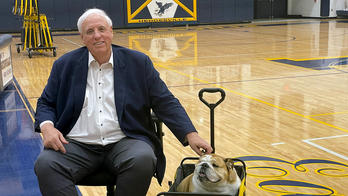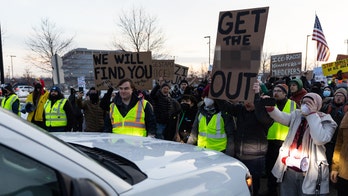
FILE: Sept. 28, 2010: A photo-enforced stop sign camera and warning sign in the Santa Monica Mountains, in Topanga, Calif. (AP)
Thinking about rolling through that stop sign the next time nobody’s looking? Think again.
On top of red-light cameras and speed cameras, some jurisdictions are starting to install stop-sign cameras in their seemingly never-ending quest to monitor drivers and catch them in the act of some ticket-able offense. California has already rolled out cameras at stop signs. Maryland and the nation's capital could be next.
Maryland right now allows only red-light cameras, but the town of Glen Echo wants the state legislature to expand government’s reach to include photo-ticketing for intersections with stop signs.
[pullquote]
Glen Echo is just a leafy, suburban Washington town wanting only one camera for an intersection that handles roughly 200,000 vehicles a year.
But the country’s biggest motorist-advocacy group has concerns about changes to Maryland law leading to a proliferation of the still-new enforcement technology.
“This could be the camel’s nose under the tent,” AAA mid-Atlantic spokesman John B. Townsend II told FoxNews.com.
The District of Columbia is already considering a plan to spend $5.8 million on a traffic-enforcement plan that would include stop-sign cameras and ones that could detect and ticket vehicles speeding up to get through a yellow light.
Critics of such programs argue they are more about generating cash than making roads safer, including in the District, where some of the cameras are on four-lane roads with no homes or schools in sight. The city’s network of cameras to nab speeders and red-light runners last year took in roughly $55 million, according to AAA.
“The push for more automated traffic enforcement has nothing to do with revenue,” Police Chief Cathy L. Lanier said this spring in support of expanding the automated program. “I'm motivated to promote traffic safety because I don't want to see anymore fatal accident victims who have been ejected from their shoes by the force of the crash impact.”
Beyond more stop-sign cameras being added to the thousands of other cameras already in more than 550 communities across the country, Townsend has concerns about the technology and how Maryland legislators might rework the statute.
He says the law now reads that all four wheels must come to a stop.
“That’s so nebulous that nobody knows what you mean,” Townsend said. “And for how long do you have to be stopped?”
Still, Townsend points out that 40 percent of all fatal crashes in the country occur at intersections with stop signs.
Such cameras are already in the Santa Monica Mountains just west of the city of Los Angeles, which last year shut off its 32 red-light cameras amid questions about their effectiveness and problems collecting fines.
The seven cameras in the mountain parks -- from the Hollywood Hills to the Malibu coast -- took in a reported $2.4 million in fiscal 2010, despite posted warnings.
























